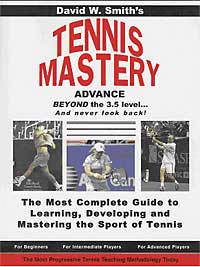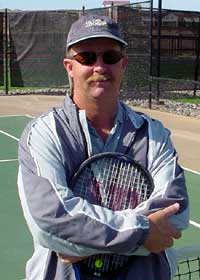| TennisOne Lessons Using your Goals to Develop the Proper Practice Plan Dave Smith TennisOne Senior Editor Last month I outlined many of the elements that can determine a player’s potential (see article) - that which will have a direct influence in how far a player can improve and what levels they could expect.
Obviously, if a player used ineffective tennis strokes or mechanics, the use of such techniques will seriously limit that player’s ability to advance to more skilled levels of competitive play. Usually, such players manipulate their strategy to accommodate their limited strokes. Often these players resort to a pushing or dinking style of play since flawed strokes tend to inhibit the amount of spin, pace, and control they can impart on the ball and those are precisely the elements that contribute to effective shot-making. Players may recognize (or be told) that their current stroke technique will limit their development, however, anyone who has tried to change an existing stroke pattern quickly becomes aware that it is much more difficult than it appears. For example, most players think that learning a new grip for the volley is just that, master a new grip. However, most strokes in tennis are grip-dependent. Meaning, that not only does the new grip need to be mastered, but elements such as contact point, relative body position, swing path, and footwork usually need to be re-engineered also! (It is never just a grip change!)
In this light, it is important that a player identify his or her goals as they relate to how good they would like to be. For example, if I were approached by a person with a terminal illness who had only weeks to live and this person wanted to play tennis reasonably well before they died, I would teach them a different style of play than a person who has a normal life expectancy. This is because, if I wanted to simply play tennis and not concern myself with advancing past mediocre levels, I would want to learn methods that quickly satisfy my need for simply ‘hitting a ball in a general desired direction!’ Unfortunately, many players believe that this acquisition of mediocre strokes is the pathway to more advanced play. In fact, such a progression usually leads a player to stagnating far below their potential. Perhaps for some, this limited progression is sufficient. However, I suspect that most players who pick up a tennis racquet, even those who are attempting it for the first time, have a desire to see how good they could be. Most players have seen tennis on television or played relatively well. The ambition to hit a ball with fluid, effective strokes and with a high level of control, as demonstrated by those who have mastered the game, is enviable. In my experience, few players lacked the ability to reach high levels of tennis mastery. In fact, the vast majority of players who stagnate at low levels of tennis skill learned the game in such a way that prevented them from reaching their potential rather their lack of progress being blamed on ability, desire or opportunity. So, with that said, it will be assumed that you now know that, regardless of age, sex, size or previous tennis experience, you can achieve very high levels of tennis skill.
Yet, even though I may have convinced you that you can play tennis skillfully, you may be one that says, "Hey, I don’t have the time or energy to do all that might be necessary to reach such potential.” And, you might very well be right. Or, you are older and feel that you don’t have the desire to reach really high levels of play but want to play better within your circle of tennis friends. Thus, because of these variations in goals, your practice plan can be developed accordingly. Within this article I will offer some varied ‘practice plans’ based on the desired level of play one would initially like to reach. I say, ‘initially’ because if a player learns the methods of the Advanced Foundation, every player can, and usually does, exceed initial expectations!
Because you (or your kids) are wanting to learn the game to play it well, especially since tennis is a game you can play for the rest of your life, you will want to know the methods in which you will want to practice. If this is indeed your goal, then a set of private lessons are ideal for starting out. Most pros will introduce you to the proper grips, swing patterns, and footwork required in order to succeed. However, be careful of pros who offer methods that require change later on. Ask your pro, “Is this a method I will have to change if I want to reach higher levels of play.” If the answer is “yes,” then you will probably want to find another pro. Because learning simple methods that may provide some level of instant gratification will limit your development. You do NOT want to spend time learning such methods if you will have to change them at some later point.
It should be noted here, that I don’t recommend playing competitive tennis for a while, usually a month or more during this initial process. Because competitive tennis encourages players to revert back to comfortable or familiar techniques, (because winning is such a powerful motivator), I tell beginning players to avoid competitive play. While it is always fun to start playing tennis quickly, if the goal is to master advanced stroke patterns, it is important to give such practice ample time to develop a comfortable, familiarity with new techniques without falling back to less sophisticated stroke elements to perceive a sense of confidence that more simple patterns tend to provide. I doubt many people who subscribe to TennisOne are strictly social or recreational players. While many players may only play tennis ‘socially’ or for exercise, I have found few that still would not mind playing better tennis.
I have seen many of these unique players, players who don’t necessarily hit shots with the pace, spin, or control I mentioned earlier, play very smart tennis. That is, they know what shots won’t get them in trouble, and where they need to position themselves to again, not get themselves in trouble! I have several newsletters that address the strategies of doubles for this very player. There are doubles secrets that, when mastered, help players who may have less prolific strokes literally dominate those who do. These are the players who sometimes tear up players who may have far better strokes, but not the smarts. So make sure you study strategic tennis as well as stroke production. Your comments are welcome. Let us know what you think about Dave Smith's article by emailing us here at TennisOne .
TENNIS MASTERYFinally. a resource that unlocks these mysteries: • Why do m • Why are making changes in one's game so frustratingly difficult? • What tennis teaching methods are disruptive or detrimental to player progression? Read David W. Smith's TENNIS MASTERY and learn not just how to avoid playing at mediocre levels, but how the best players in the world Master the sport of tennis! "With a depth of knowledge and fresh perspective, TENNIS MASTERY is set to become a manual for tennis instructors and a measure for tennis literature." Richard Wigley, Director, Kayenta Tennis Center, Ivins Utah. Take in David Smith's 30 plus years in the tennis teaching industry. This 335-page manual will provide for every level of player as well as support for all tennis-teaching professionals, a blueprint for reaching higher levels of tennis mastery. Order TENNIS MASTERY at tenniswarehouse.com , or go to tennismastery.net for exciting excerpts from the book and a host of tennis information! And check out David Smith's other articles found here at TennisONE.com Learn more from Dave Smith at his Desert Shadows Tennis Institute!
Next available DSTI camps are November 28th - 30th and December 5th - 7th! Space is limited! Call (435) 628-5000 and ask for the tennis pro shop to learn more about Desert Shadows Tennis Institute. Learn the Advanced Foundation, discover tools to master more advanced techniques for all strokes, and discover that staying at the same level you are is NOT AN OPTION! A select number of camps are available but space is very limited. The DSTI camps take place in St. George, Utah, in the heart of ‘Color Country’—the incredible beauty of Southern Utah. Zion, Bryce Canyon and Grand Canyon National Parks are all nearby! Hurry to reserve your spot now for a true ‘tennis destination’ opportunity! “The most informative, intuitive tennis camp I have ever attended.” Randy S. Colorado “Dave and his staff have a passion for the game and a personal care for their students.” S. Loo, Nevada “The depth of instruction is far superior to that of other tennis camps I’ve been.” Tom T. Nevada |

 illions of tennis players stagnate at levels far below their potential?
illions of tennis players stagnate at levels far below their potential?  Join Dave Smith in an intimate, ultimate tennis camp: Desert Shadows Tennis Institute (DSTI) is an intense, 3-day camp that accepts only 12 players to work directly with Dave and his staff of certified and accomplished pros. Over 18 hours of tennis instruction is included along with a copy of Dave’s best-selling tennis book, TENNIS MASTERY, a DVD of instruction, breakfast and lunch each day, and a lifetime of tennis secrets!
Join Dave Smith in an intimate, ultimate tennis camp: Desert Shadows Tennis Institute (DSTI) is an intense, 3-day camp that accepts only 12 players to work directly with Dave and his staff of certified and accomplished pros. Over 18 hours of tennis instruction is included along with a copy of Dave’s best-selling tennis book, TENNIS MASTERY, a DVD of instruction, breakfast and lunch each day, and a lifetime of tennis secrets!